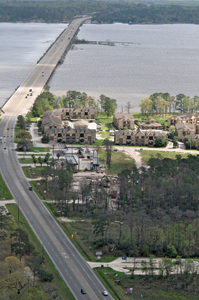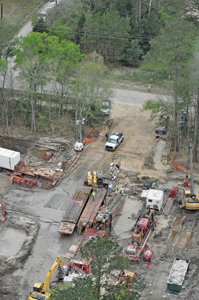NEW INSTALL WINNER: Record-Setting Lake Houston HDD Project
October 11, 2012
 Projects that involve record-setting lengths tend to get some attention. But when you look further into such a project’s details, that’s where the crux of any award-winning and challenging project is found.
Projects that involve record-setting lengths tend to get some attention. But when you look further into such a project’s details, that’s where the crux of any award-winning and challenging project is found. The Lake Houston HDD project that Laney Directional Drilling completed this past March just outside of Houston had the record-setting distance — 10,971 ft — to make the headlines but the contractor also managed the logistical and site challenges such a project brings with professionalism and innovation to make the work seem almost routine — almost.
The Lake Houston HDD Project is the 2012 Trenchless Technology Project of the Year for New Installation.
“This was the first crossing of more than two miles. We’ve shown we can use the pilot hole intersect method to drill longer crossings,” says Grady Bell, vice president of business development at Laney. “Instead of considering 7,000 to 8,000-ft drills, we can now realistically look at crossings of 14,000 to 15,000 ft long.”
Project Details
Kinder Morgan needed to replace its existing pipeline that parallels the FM 1960 bridge crossing Lake Houston in northeast Harris County, Texas. The pipeline needed to be deeper in the lake, as it was becoming exposed and boats were scrapping it. The HDD crossing originally started as a design-build project and included a 6-in. diameter steel gas pipeline with a 0.432 wall thickness, fusion-bonded epoxy coating and an abrasion-resistant overlay. The plan was to install the new pipe some 120 ft below the lake’s bottom.
 Sunland Construction served as the pipe contractor, and Laney was the HDD sub-contractor called in to complete the project after the first HDD sub-contractor could not. Laney completed the record length drill in just over two weeks. But coming in after the first contractor was unsuccessful, presented challenges for Laney beyond the installation itself, including maneuvering around existing pilot holes and abandoned assemblies/tooling in the ground.
Sunland Construction served as the pipe contractor, and Laney was the HDD sub-contractor called in to complete the project after the first HDD sub-contractor could not. Laney completed the record length drill in just over two weeks. But coming in after the first contractor was unsuccessful, presented challenges for Laney beyond the installation itself, including maneuvering around existing pilot holes and abandoned assemblies/tooling in the ground.“We were called in as the second HDD subcontractor to complete the work after the first subcontractor encountered some issues,” says Paul Bearden, Laney director of research, development and quality and director of international operations. “There were quite a few holes, which added to the complexity of our operation because not only were we trying to re-design the project to accommodate for a new profile and alignment associated with just subsurface conditions, but we had all that material to get around, which led to concerns about our drilling fluid management.”
Laney prepared a drilling fluids management plan based on the subsurface conditions and this aspect of the project was managed by GHG Corp, Houston. “By following the drilling fluid plan, we were able to experience very little if any torque on that entire length of drill pipe, which we attribute to the engineering design component, operational efficiencies and the drilling fluids plan — the complete package,” Bearden says.
One key to the successful HDD design was avoiding the previously attempted pilot holes and lost tools left down hole by the first HDD sub-contractor. Snider explains, “Everyone assumed we would go deeper than the first crossing attempt that was at about 160 to 180 ft, but we decided there was a better formation of good, dense sand at about 120 ft depth.”
Laney picked the dense sand to reduce the potential for inadvertent returns and hydraulic fracture. It also wanted to be above the lost downhole tooling to reduce the interference and pilot hole surveying issues its drillers might have encountered from these undesirable obstacles.
The HDD design also included a side bend of 17.5 degrees, which normally is not a challenge on shorter crossings. John Odom, one of Laney’s field superintendents on the record-breaking project says, “It takes a lot of torque to turn that much drill pipe. We just had to take the side bend gradually and make sure we had really good drilling fluid in the hole at all times.”
“That curve was a left-hand turn and we needed to stay in the Kinder Morgan right of way,” Bearden says. “It was very challenging, especially because this was done under water in which there is no wire coil to track.”
Kevin Barton, the other experienced Laney field superintendent on the project, agrees that managing the drilling fluid was another key to success. “We had a mud engineer onsite during construction to keep the fluid right. With this length, we needed to carefully consider things like the viscosity of the mud and PH of the water.”
Both Odom and Barton have been working as HDD drillers for nearly 20 years each, and this was the longest crossing either had participated in.
Besides the record-setting length, the Lake Houston HDD crossing had logistical challenges at both the entry and exit locations. On the entry side, Laney had to set up its rig between two existing, in-service pipelines. Odom explains that a normal dead man setup is 16 ft wide; however, Laney only had 15 ft to work with between the two “hot” pipelines.
The dead man and LDD-750 rig on the exit side also had to be modified to fit in the space available, and Laney even had to move a section of old pipeline at the site to fit the drilling equipment. Other obstacles acting as work site constraints included railroad tracks, a gas station and apartment complexes to name a few. Odom says the alterations to the drilling equipment were made on the spot as they didn’t know the full extent of the space restrictions until they arrived on site.
After Laney adjusted to site conditions, a crew from each side drilled toward the middle of Lake Houston. A mile and a half of the crossing was under water. Barton and Odom worked from the exit side because that is where the 17.5 degree bend was designed. After the drill pipes intercepted, Barton explains that he and Odom took their drilling experience to the entry side to help push the drill pipe out all the way to the exit side of the crossing.
Having the second half of the crossing already drilled via the pilot hole intersect method made it possible to push the drill pipe successfully for such a long length. No reaming was required, so after the drill pipe was through to the exit side, Laney proceeded to pull the product pipe through the nearly 11,000-ft hole.
 “As far as the pullback, everything went well,” says Odom. “We worked 24-hour days, in two shifts per day to keep the pipe moving, stopping only to make each of the tie-in welds.” Because of the space restrictions on the exit side of the crossing the pipe contractor, Sunland, had to make three tie-in welds in the rain as pipe pullback was completed.
“As far as the pullback, everything went well,” says Odom. “We worked 24-hour days, in two shifts per day to keep the pipe moving, stopping only to make each of the tie-in welds.” Because of the space restrictions on the exit side of the crossing the pipe contractor, Sunland, had to make three tie-in welds in the rain as pipe pullback was completed. The Laney team also credits the following for their work and efforts in this project: INROCK, which aided in the pilot hole surveying, GHG Corp. for its drilling fluid management, as well as specific members of the Laney team: Laney project manager; and Kevin Barton and John Odom, Laney superintendents.
The Laney team is proud of this nearly 11,000-ft crossing and say that such successful crossings open the door for even longer ones. “Clients are seeing that being successful at that length has opened a lot of owners’ eyes that we can go even longer,” says Alan Snider, Laney vice president of engineering. “There are several crossings out there that we are designing and that are being designed elsewhere to go this length or longer.”
This article was based on article written by Laney Directional Drilling, with additional information supplied by Sharon M. Bueno, managing editor of Trenchless Technology.
Project Owner:Kinder Morgan
Contractor: Sunland Construction
HDD Subcontractor: Laney Directional Drilling
